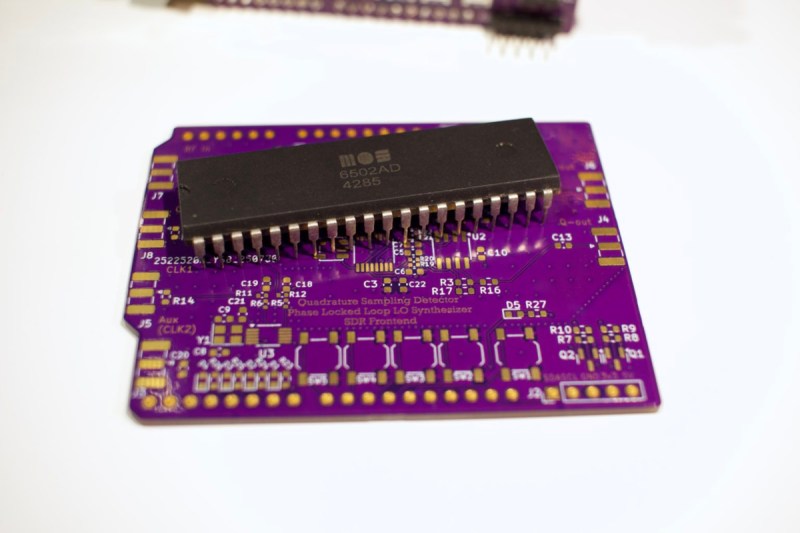The legendary 6502 microprocessor recently turned 50 years old, and to celebrate this venerable chip which brought affordable computing and video gaming to the masses [AndersBNielsen] decided to put one to work doing something well outside its comfort zone. Called the PhaseLoom, this project uses a few other components to bring the world of software-defined radio (SDR) to this antique platform.
The PhaseLoom is built around an Si5351 clock generator chip, which is configurable over I2C. This chip is what creates the phase-locked loop (PLL) for the radio. The rest of the components, including antenna connectors and various filters, are in an Arduino-compatible form factor that let it work as a shield or hat for the 65uino platform, an Arduino-form-factor 6502 board. The current version [Anders] has been working on is dialed in to the 40-meter ham band, with some buttons on the PCB that allow the user to tune around within that band. He reports that it’s a little bit rough around the edges and somewhat noisy, but the fact that the 6502 is working as an SDR at all is impressive on its own.
For those looking to build their own, all of the schematics and code are available on the project’s GitHub page. [Anders] has some future improvements in the pipe for this project as well, noting that with slightly better filters and improved software even more SDR goodness can be squeezed out of this microprocessor. If you’re looking to experiment with SDR using something a little bit more modern, though, this 10-band multi-mode SDR based on the Teensy microcontroller gets a lot done without breaking the bank.
















Thanks for the mention!
I think it’s more my “two pieces of wire in the attic” antenna that’s picking up noise rather than the design.
The quadrature sampling detector doesn’t have as much selectivity as the alternatives but the sensitivity is probably a good thing.
The question is if I can get a reasonable amount of analog bandwidth out of it – stay tuned for tests :)
It’s a cool project, well done. I shall check out the github repository.
Seeing this has brought back long-dormant memories of the time, back in ’93-94, when I wrote a front-end to control a multiband radio scanner in AMOS Basic for the Amiga. It seemed impossibly high-tech (to me) at the time but is something that would be trivial today.
Thanks for sharing this!
“6502-controlled radio receiver front-end” is by itself a really nice project, nothing to sneeze at. I know it’s not litereally stated anywhere in the original post, but this 6502 has nothing to do with SDR, or any other kind of receiver you connect up to it.
(So I guess I am now also “that guy”. I promise I will get my morning coffee ASAP.)
Coffee is done.
@Anders: first of all, thanks for the write-up and sharing/sources/etc. Hope that comments like mine do not discourage you to do stuff and write about it.
I think my assumption is that the word SDR was added to get peoples attention. If that’s not true, I can stop here.
Now I’m fighting a battle with myself. I really like these articles and reading about other peoples endeavours. I enjoy the reading and from time to time learn something new. I think sharing these experiences is also vital to get people interested in technology.
However, getting to understand difficult technical subjects is often quite an involving process. Getting the facts straight and developing a thorough understanding of the subject does not need to get more difficult by the need to filter out marketing/SEO buzz words.
But in order to share and teach, we need people to actually start reading and get the word out. So I am now asking myself: where should we draw the line between “getting the story out” and “keeping the facts straight”. I honestly don’t know if I would have read the article if the word “SDR” was to be omitted.
(Or maybe I am just disappointed that I misjudged the contents by its title?)
TLDR: this is getting way too philosophical for my taste ;) I won’t comment without having my coffee anymore. Keep sharing cool stuff!
So the MCU in the HackRF One has nothing to do with SDR? Of course it does – and the 6502 has the same role here :)
Without it, it would just be.. a radio.
Anyone who does anything these days with a 6502 has my admiration. Keep the spirit of discovery alive.
This makes me want to get out one of my VIC-20’s and make a GUI for a radio front end. Nice job.
So the 6502 is working as the controller/front-end/computer interface? Reminds me of a CAT circuit.^^
https://en.wikipedia.org/wiki/Computer_aided_transceiver
Well, the 6502 handles setting the mixer frequency and ensuring the quadrature phase of the other channel.
It has the same job as the NXP MCU in the HackRF One.
I think a dab of paint (on the PCB labels), would be easier than physically swapping the I and Q channels.
So with everyone ” banging on” about the ol 6502 why don’t they design a giga hertz clocked version. It would make a great RISC, ease of use, make the instructions 32 or64 bit and get on with it.?????